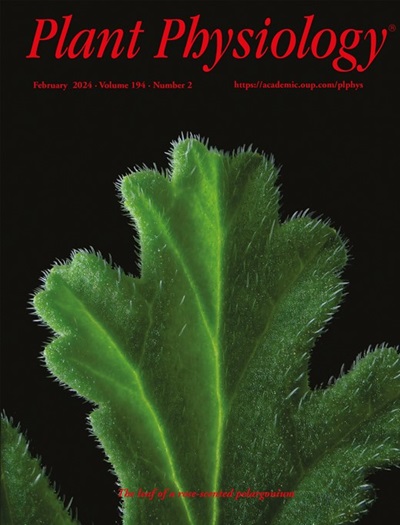The wheat lesion mimic 34 mutant shows lesion mimicry and enhanced reactive oxygen species-mediated immunity to powdery mildew
IF 6.5
1区 生物学
Q1 PLANT SCIENCES
引用次数: 0
Abstract
Lesion mimicry typically manifests as leaf disease-like symptoms in the absence of pathogen infection, characterized by a hypersensitive response (HR), which is intricately linked to plant disease resistance. In this study, the wheat (Triticum aestivum L) mutant lesion mimic 34 (lm34), harboring a recessive mutation in the Zhongyou 206 (ZY206) background, was comprehensively investigated. The lm34 mutation was mapped to a 140-kb region on chromosome 4AL through bulked segregant exome capture sequencing (BSE-Seq) and fine-mapping. Sequence comparison and phenotypic analysis of the lm34Jing mutant revealed that TraesCS4A03G1225400, encoding a typical CC-NB-LRR protein, is the causal gene in lm34. Transient expression assays in Nicotiana benthamiana leaves indicated that the TaLM34 extended coiled coil (eCC) domain can induce cell death. Furthermore, lm34 mutants display elevated reactive oxygen species (ROS) levels and significantly increased expression of pathogenesis-related (PR) genes (PR2 and PR10), leading to enhanced powdery mildew resistance. Our findings suggest that TaLM34 can serve as a potential target for the development of wheat cultivars with improved disease resistance. Overall, our study sheds light on the molecular mechanisms underlying wheat disease resistance and cell death.小麦病变模拟34突变体表现出病变模拟和增强的活性氧介导的白粉病免疫
在没有病原体感染的情况下,病变模仿通常表现为叶片疾病样症状,其特征是超敏反应(HR),这与植物的抗病能力有着复杂的联系。本研究对中优206 (ZY206)背景隐性突变的小麦(Triticum aestivum L)突变体损伤模拟物34 (lm34)进行了全面研究。通过大规模分离外显子组捕获测序(BSE-Seq)和精细定位,将lm34突变定位在4AL染色体上140kb的区域。对lm34Jing突变体的序列比较和表型分析表明,编码典型CC-NB-LRR蛋白的TraesCS4A03G1225400是lm34的致病基因。在烟叶中的瞬时表达实验表明,TaLM34扩展线圈结构域(extended coil coil coil, eCC)可诱导细胞死亡。此外,lm34突变体表现出活性氧(ROS)水平升高,致病相关(PR)基因(PR2和PR10)的表达显著增加,导致白粉病抗性增强。我们的研究结果表明,TaLM34可以作为培育抗病小麦品种的潜在靶点。总之,我们的研究揭示了小麦抗病和细胞死亡的分子机制。
本文章由计算机程序翻译,如有差异,请以英文原文为准。
求助全文
约1分钟内获得全文
求助全文
来源期刊

Plant Physiology
生物-植物科学
CiteScore
12.20
自引率
5.40%
发文量
535
审稿时长
2.3 months
期刊介绍:
Plant Physiology® is a distinguished and highly respected journal with a rich history dating back to its establishment in 1926. It stands as a leading international publication in the field of plant biology, covering a comprehensive range of topics from the molecular and structural aspects of plant life to systems biology and ecophysiology. Recognized as the most highly cited journal in plant sciences, Plant Physiology® is a testament to its commitment to excellence and the dissemination of groundbreaking research.
As the official publication of the American Society of Plant Biologists, Plant Physiology® upholds rigorous peer-review standards, ensuring that the scientific community receives the highest quality research. The journal releases 12 issues annually, providing a steady stream of new findings and insights to its readership.
 求助内容:
求助内容: 应助结果提醒方式:
应助结果提醒方式:


